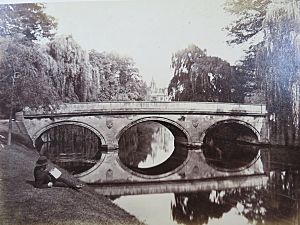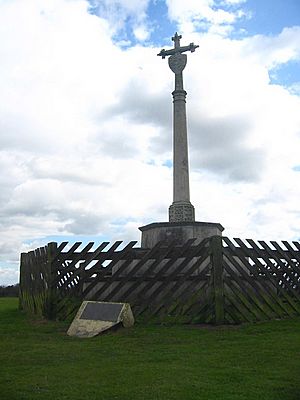James Essex facts for kids
James Essex (born 1722, died 1784) was a skilled English builder and architect. He spent most of his life working in Cambridge, the city where he was born. He helped design parts of many famous colleges of the University of Cambridge. He also did important repair work on the cathedrals in Ely and Lincoln. James Essex really admired Gothic architecture, which is a style of building with pointed arches and tall spires. He even collected information to write a book about it, but it was never published.
Contents
Early Life and Family Business
James Essex was born in Cambridge in August 1722. His father, who was also named James Essex, was a builder too. His father worked on important buildings like the Senate House and the hall at Queens' College, Cambridge.
Young James went to a grammar school at the school of King's College, Cambridge. After that, he learned from a famous architect named Sir James Burrough. When his father passed away in 1749, James Essex took over the family building business. One of his first big projects was building the unique Mathematical Bridge at Queens' College in September 1749.
Working with Cambridge Colleges


For the next 25 years, James Essex was very busy working for the colleges in Cambridge.
- In 1757, he designed and built the Ramsden Building at St Catharine's College.
- In 1758, he repaired parts of Nevile's Court at Trinity College.
- In 1760, he designed and built a new section at Queens' College.
- In 1764, he repaired the hall at Emmanuel College.
- In 1766, he designed and built the stone bridge at Trinity College.
- In 1769, he worked on the first court of Christ's College and finished the chapel at Clare College.
- In 1775, he rebuilt the old Great Hall of Trinity College into a new "Combination Room." He also designed the west front of Emmanuel College.
- In 1776, he designed and set up the altarpiece at King's College Chapel. He also changed the south side of the first court at St John's College.
- Between 1778 and 1782, he made bookcases for the library and designed the chapel at Sidney Sussex College.
Essex also worked on the University Library. In 1751, he set up a special room for old manuscripts. He also designed bookcases for the old library that are still used today. In 1768, he finished the west end of the Senate House, which had been left unfinished by another architect.
Beyond the colleges, in 1754, he rebuilt Magdalene Bridge. In 1784, he designed and built the old Cambridge Guildhall.
Important Church Work
While working in Cambridge, James Essex mostly used the Italianate style, which was popular at the time. However, he also loved the Gothic style, which was not very popular back then. He was one of the first professional architects to copy medieval English buildings.
- In 1757, he started working on Ely Cathedral. For the next five years, he repaired the front and the roof. He also moved the choir (the part of the church where the singers sit) to a new spot.
- In 1760, he built a gallery in Great St Mary's Church.
- In 1761, he took on a big project at Lincoln Cathedral, where many repairs were needed. He built an arch, repaved the church, and designed an altarpiece and a bishop's throne. He also tried to move the choir here, just like at Ely, but it didn't happen.
- In 1775, he designed and put up four spires and a battlement (a wall with gaps for defense) on the central tower of Lincoln Cathedral.

Essex also repaired the tower of Winchester College Chapel and changed Madingley Hall in Cambridge. He built the steeple of the church in Debden, Essex. At Ampthill Park, he built a cross in 1773 to remember Queen Catherine of Aragon.
Friends and Reputation
James Essex had many friends who were also interested in history and old buildings, like Michael Tyson and William Cole. He even built William Cole's house. He was also friends with Horace Walpole, who had a famous Gothic-style house called Strawberry Hill. Essex worked for Walpole for a few years, adding the Beauclerk Tower in 1777.
He became a Fellow of the Society of Antiquaries in 1772. He wrote articles about architectural history for a magazine called Archæologia. He also planned to publish drawings and plans of King's College Chapel, and many of his drawings and notes for his unfinished History of Gothic Architecture are now in the British Museum.
In 1748, when he was 26, James Essex had a disagreement with a historian named Robert Masters. Masters had used a plan drawn by Essex and claimed it as his own. Essex then published his own design and criticized Masters.
Family Life
James Essex married Elizabeth Thurlbourne, whose father was a bookseller in Cambridge. They had two children. Their son, James, died when he was a baby in 1757. Their daughter, Millicent, married John Hammond in 1785 but passed away in 1787.
Death
James Essex died in Cambridge on September 14, 1784, when he was 62 years old. He was buried in St Botolph's churchyard in Cambridge. A tombstone there remembers him, his parents, his wife, and his children. There is also a tablet inside the church that remembers him and his children.
|
![]() This article incorporates text from a publication now in the public domain: Clark, John Willis (1889). "Essex, James". Dictionary of National Biography 18. Ed. Leslie Stephen. London: Smith, Elder & Co. 5,6,7.
This article incorporates text from a publication now in the public domain: Clark, John Willis (1889). "Essex, James". Dictionary of National Biography 18. Ed. Leslie Stephen. London: Smith, Elder & Co. 5,6,7.

